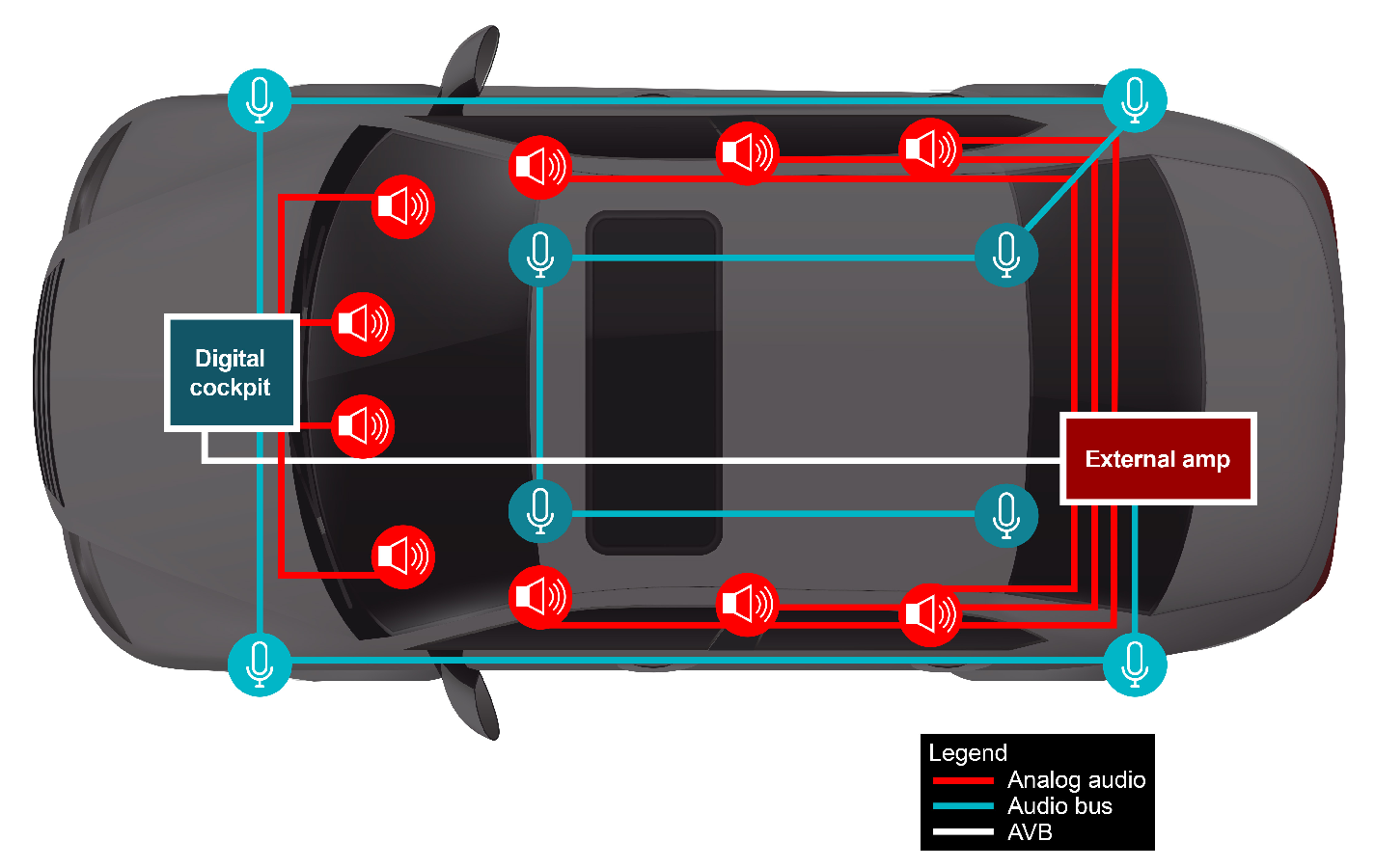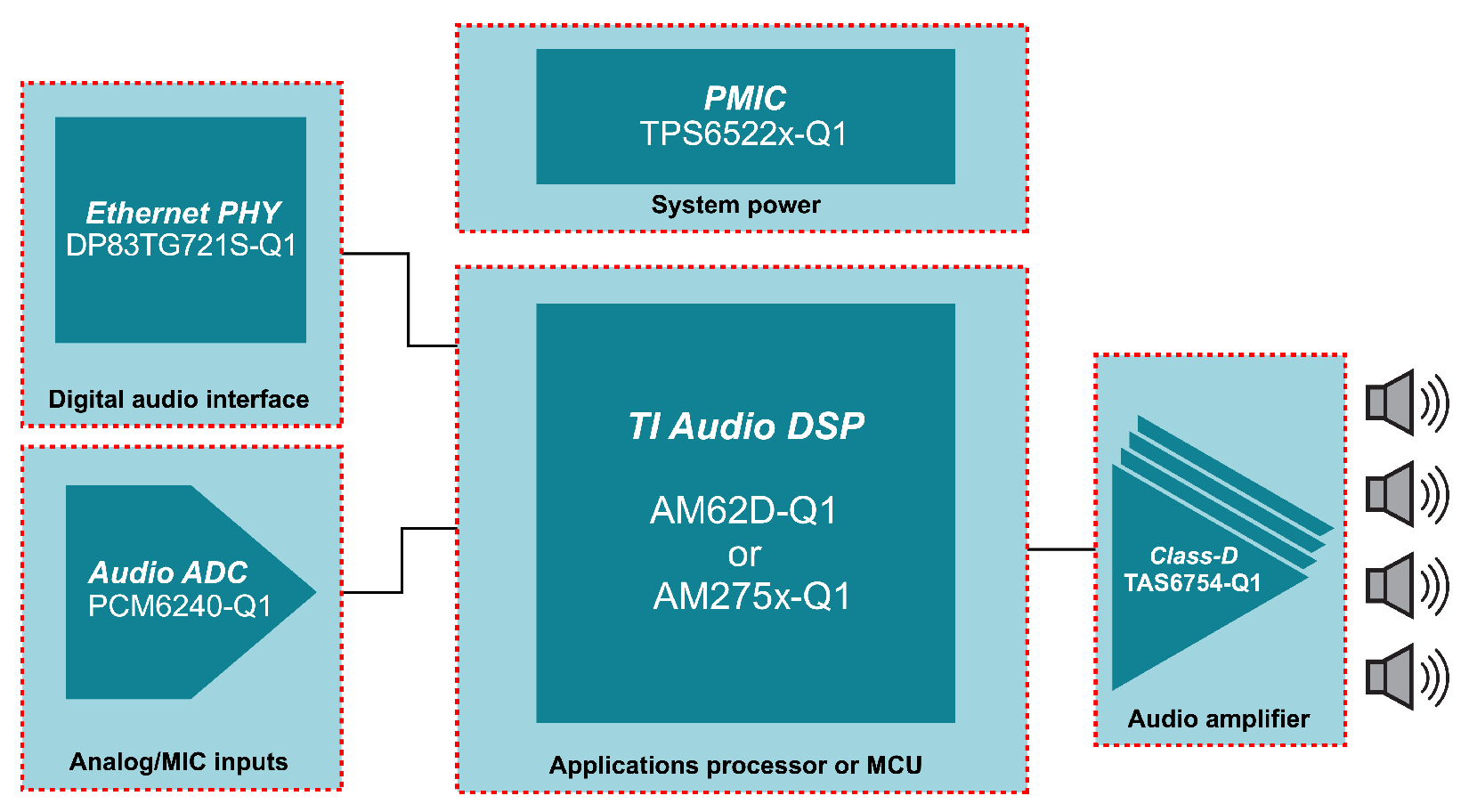SSZTD66 December 2024 AM62D-Q1
Automotive audio has evolved from entertainment-only purposes to being an integral part of the driving experience in an effort to enhance driver comfort and safety. Audio features such as active noise cancellation (ANC), immersive surround sound and personalized audio zones – traditionally limited to high-end vehicle models – are now making their way into entry-level models.
To keep pace with this trend while making vehicles more efficient and easier to manufacture, original equipment manufacturers (OEMs) and audio system designers are looking for higher levels of integration in the embedded processors used in automotive amplifiers. These processors need to meet system audio processing demands and OEM security and functional safety requirements. Audio system designers also want these systems to be scalable, simplifying redesign across OEMs and vehicle trim models.
In this article, we’ll explore the evolution of embedded devices such as the TI AM62D-Q1 processor and AM2754-Q1 microcontroller (MCU), as well as the most important design considerations when using these devices with other advanced semiconductors to develop digital amplifiers in modern vehicles.
The evolution of automotive audio processors and supporting components
Audio continues to be a differentiating factor between OEMs. In fact, most OEMs provide packages that add on to or replace stock sound systems such as premium-branded sound systems, branded immersive surround-sound capabilities, extra mid-range speakers and subwoofers. If you’ve shopped for a car recently, you’re probably familiar with the range of audio options in currently available models.
Traditionally, digital amplifiers in premium automotive audio systems were designed with a distributed architecture for audio processing, with separate MCUs, digital signal processors (DSPs) and networking integrated circuits (ICs) handling different tasks. While this discrete approach often provided design flexibility, it also increased system complexity, cost and size. The addition of immersive surround sound and road-noise cancellation (RNC) for a home-theater like experience – while also optimizing fuel and energy efficiency at the same time – requires an increase in the number of components, audio channels and types of software. Figure 1 shows an example of an audio system in a modern vehicle with multiple speakers for surround sound, as well as microphones for RNC.
 Figure 1 Diagram of modern audio system
with speakers for surround sound and microphones for RNC
Figure 1 Diagram of modern audio system
with speakers for surround sound and microphones for RNCHigher levels of device integration in embedded processors are helping streamline the design of audio systems. For example, highly integrated automotive SoCs in AM62D-Q1 processors and AM275x-Q1 MCUs feature TI’s C7x DSP cores, memory and components designed to help you achieve external functional safety, security requirements, and audio networking requirements all in a single device.
A single-chip processing platform also simplifies scalability from a hardware and software perspective, since these MCU and processor families include pin-to-pin compatible options, and enables code reuse across designs.
From a vehicle safety perspective, these devices help increase audio performance outside of the car by simplifying the design of sound synthesis systems such as engine sound synthesis or acoustic vehicle alerting systems in battery electric vehicles. These systems enhance vehicle safety by emitting sounds from external speakers that pedestrians outside the vehicle can hear, as well as emitting sounds that replicate engine noise inside the vehicle.
Each C7x DSP core also includes a single-cycle L2 memory cache (accessible up to 2.25MB) for up to four times higher processing performance than traditional scalar-based audio DSPs and is paired with a matrix multiply accelerator to form an on-chip neural processing unit (NPU). This architecture can process both traditional and edge AI-based audio algorithms, enabling single-chip support for multiple premium audio features.
These advanced audio features also help maintain compatibility with performance audio amplifiers such as the TAS6754-Q1 with one inductor (1L) modulation technology, analog-to-digital converters, and power-management integrated circuits (PMICs) such as the TPS65224-Q1 – completing the audio signal chain in modern vehicles. Figure 2 shows a block diagram of a premium audio system with TI embedded processors, analog and power ICs.
 Figure 2 End-equipment block diagram of
a fully featured premium audio system
Figure 2 End-equipment block diagram of
a fully featured premium audio systemSimilar to advancements in automotive audio processors, higher levels of integration in PMICs like the TPS65224-Q1 are helping designers create scalable, compact, and reliable automotive audio systems that meet OEM and – ultimately - consumer expectations by fully leveraging their system’s processors and helping reduce overall BOM cost and size at system level. These devices also feature integrated functional safety features to achieve ASIL-B at system level.
Conclusion
Highly integrated audio processors with DSP capabilities are enabling a new generation of premium automotive audio systems, with immersive sound, ANC and personalized audio features. However, realizing the full potential of these processors requires an optimized embedded software architecture and development process.
By considering factors such as DSP software architectures, audio frameworks, tuning tools and software reuse, automotive system engineers can unlock the capabilities of advanced audio silicon while managing the complexity of in-vehicle system integration. As the demand for premium audio continues to grow, a focus on both hardware and software innovation will be the primary factor to staying competitive in the automotive market.
Additional resources
- Technical article, “Shrinking automotive audio system designs with Class-D amplifier 1L modulation.”
Trademarks
All trademarks are the property of their respective owners.